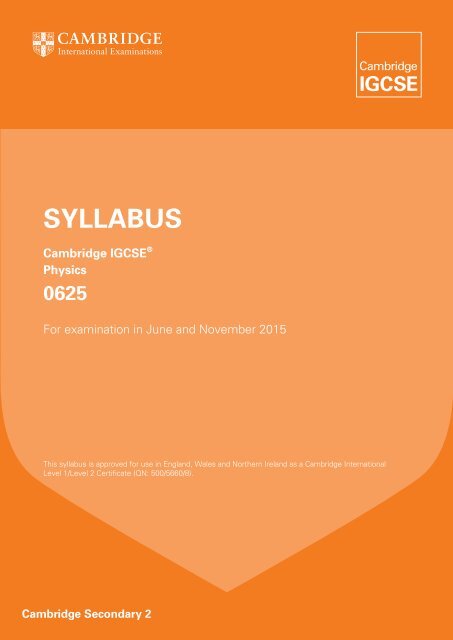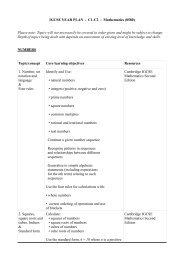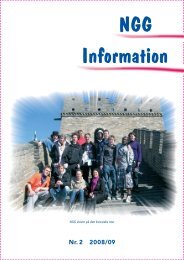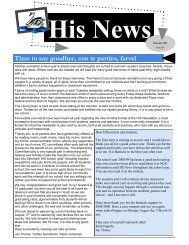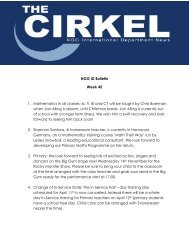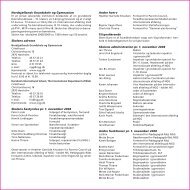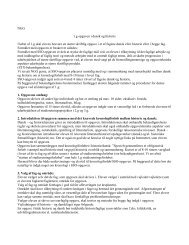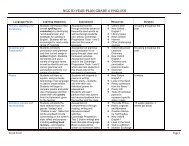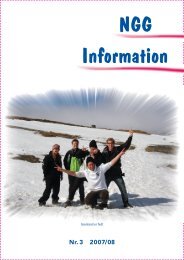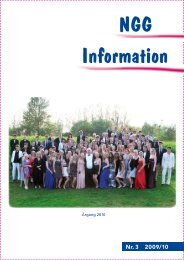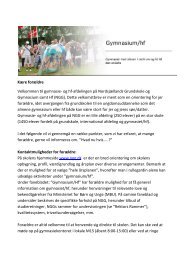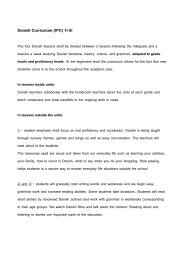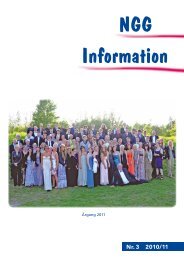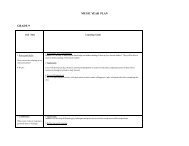IGCSE Physics
IGCSE Physics
IGCSE Physics
- No tags were found...
You also want an ePaper? Increase the reach of your titles
YUMPU automatically turns print PDFs into web optimized ePapers that Google loves.
SYLLABUSCambridge <strong>IGCSE</strong> ®<strong>Physics</strong>0625For examination in June and November 2015This syllabus is approved for use in England, Wales and Northern Ireland as a Cambridge InternationalLevel 1/Level 2 Certificate (QN: 500/5660/8).Cambridge Secondary 2
Changes to syllabus for 2015This syllabus has been updated, but there are no significant changes to the syllabus content.The standard electrical symbols candidates are expected to be able to recall and use are included inSection 8.1.The mathematical requirements of the syllabus have been clarified (see Section 8.5) and guidance onthe presentation of data has been included (see Section 8.7). The additional guidance regarding theexpectations of the practical test (Paper 5) has been updated (see Section 7.2).Significant changes are indicated by black vertical lines either side of the text.Cambridge International Examinations retains the copyright on all its publications. Registered Centres arepermitted to copy material from this booklet for their own internal use. However, we cannot give permissionto Centres to photocopy any material that is acknowledged to a third party even for internal use within aCentre.® <strong>IGCSE</strong> is the registered trademark of Cambridge International Examinations.© Cambridge International Examinations 2013
Contents1. Introduction .................................................................................................................... 21.1 Why choose Cambridge?1.2 Why choose Cambridge <strong>IGCSE</strong>?1.3 Why choose Cambridge <strong>IGCSE</strong> <strong>Physics</strong>?1.4 Cambridge ICE (International Certificate of Education)1.5 How can I find out more?2. Teacher support .............................................................................................................. 62.1 Support materials2.2 Resource lists2.3 Training3. Syllabus content at a glance ........................................................................................... 74. Assessment at a glance ................................................................................................. 85. Syllabus aims and assessment objectives ................................................................... 105.1 Syllabus aims5.2 Assessment objectives5.3 Scheme of assessment5.4 Relationship between assessment objectives and components5.5 Grade descriptions5.6 Conventions (e.g. signs, symbols, terminology and nomenclature)6. Syllabus content ........................................................................................................... 177. Practical assessment .................................................................................................... 327.1 Paper 4: Coursework7.2 Paper 5: Practical Test7.3 Paper 6: Alternative to Practical8. Appendix ....................................................................................................................... 398.1 Electrical symbols8.2 Symbols, units and definitions of physical quantities8.3 Safety in the laboratory8.4 Glossary of terms used in science papers8.5 Mathematical requirements8.6 ICT8.7 Presentation of data8.8 Forms9. Other information ......................................................................................................... 5310. Additional information for England, Wales and Northern Ireland .................................. 54
Introduction1. Introduction1.1 Why choose Cambridge?RecognitionCambridge International Examinations is the world’s largest provider of international education programmesand qualifications for learners aged 5 to 19. We are part of Cambridge Assessment, a department of theUniversity of Cambridge, trusted for excellence in education. Our qualifications are recognised by theworld’s universities and employers.Cambridge <strong>IGCSE</strong> ® (International General Certificate of Secondary Education) is internationallyrecognised by schools, universities and employers as equivalent in demand to UK GCSEs. Learn more atwww.cie.org.uk/recognitionExcellence in educationOur mission is to deliver world-class international education through the provision of high-quality curricula,assessment and services.More than 9000 schools are part of our Cambridge learning community. We support teachers in over 160countries who offer their learners an international education based on our curricula and leading to ourqualifications. Every year, thousands of learners use Cambridge qualifications to gain places at universitiesaround the world.Our syllabuses are reviewed and updated regularly so that they reflect the latest thinking of internationalexperts and practitioners and take account of the different national contexts in which they are taught.Cambridge programmes and qualifications are designed to support learners in becoming:• confident in working with information and ideas – their own and those of others• responsible for themselves, responsive to and respectful of others• reflective as learners, developing their ability to learn• innovative and equipped for new and future challenges• engaged intellectually and socially, ready to make a difference.Support for teachersA wide range of materials and resources is available to support teachers and learners in Cambridge schools.Resources suit a variety of teaching methods in different international contexts. Through subject discussionforums and training, teachers can access the expert advice they need for teaching our qualifications. Moredetails can be found in Section 2 of this syllabus and at www.cie.org.uk/teachersSupport for exams officersExams officers can trust in reliable, efficient administration of exams entries and excellent personal supportfrom our customer services. Learn more at www.cie.org.uk/examsofficers2 Cambridge <strong>IGCSE</strong> <strong>Physics</strong> 0625. Syllabus for examination in 2015.
IntroductionNot-for-profit, part of the University of CambridgeWe are a not-for-profit organisation where the needs of the teachers and learners are at the core of what wedo. We continually invest in educational research and respond to feedback from our customers in order toimprove our qualifications, products and services.Our systems for managing the provision of international qualifications and education programmes forlearners aged 5 to 19 are certified as meeting the internationally recognised standard for qualitymanagement, ISO 9001:2008. Learn more at www.cie.org.uk/ISO90011.2 Why choose Cambridge <strong>IGCSE</strong>?Cambridge <strong>IGCSE</strong>s are international in outlook, but retain a local relevance. The syllabuses provideopportunities for contextualised learning and the content has been created to suit a wide variety of schools,avoid cultural bias and develop essential lifelong skills, including creative thinking and problem-solving.Our aim is to balance knowledge, understanding and skills in our programmes and qualifications to enablecandidates to become effective learners and to provide a solid foundation for their continuing educationaljourney.Through our professional development courses and our support materials for Cambridge <strong>IGCSE</strong>s, weprovide the tools to enable teachers to prepare learners to the best of their ability and work with us in thepursuit of excellence in education.Cambridge <strong>IGCSE</strong>s are considered to be an excellent preparation for Cambridge International AS andA Levels, the Cambridge AICE (Advanced International Certificate of Education) Group Award,Cambridge Pre-U, and other education programmes, such as the US Advanced Placement programand the International Baccalaureate Diploma programme. Learn more about Cambridge <strong>IGCSE</strong>s atwww.cie.org.uk/cambridgesecondary2Guided learning hoursCambridge <strong>IGCSE</strong> syllabuses are designed on the assumption that candidates have about 130 guidedlearning hours per subject over the duration of the course, but this is for guidance only. The number ofhours required to gain the qualification may vary according to local curricular practice and the learners’ priorexperience of the subject.1.3 Why choose Cambridge <strong>IGCSE</strong> <strong>Physics</strong>?Cambridge <strong>IGCSE</strong> <strong>Physics</strong> is accepted by universities and employers as proof of knowledge andunderstanding of physics. Successful candidates gain lifelong skills, including:• an understanding of the usefulness (and limitations) of scientific method, and its application in othersubjects and in everyday life• a concern for accuracy and precision• an understanding of the importance of safe practice• an awareness of the importance of objectivity, integrity, enquiry, initiative and inventivenessCambridge <strong>IGCSE</strong> <strong>Physics</strong> 0625. Syllabus for examination in 2015.3
IntroductionCambridge <strong>IGCSE</strong> <strong>Physics</strong> also provides opportunities for students to:• become confident in a technological world, with an informed interest in scientific matters• develop an understanding of how scientific theories and methods have developed, and continue todevelop, as a result of groups and individuals working together• understand that the study and practice of science are affected and limited by social, economic,technological, ethical and cultural factors• develop an awareness that the application of science in everyday life may be both helpful and harmful tothe individual, the community and the environment• appreciate that science overcomes national boundaries and that the language of science, used correctlyand thoroughly, is universal• develop an interest in, and care for, the environmentRecommended prior learningWe recommend that candidates who are beginning this course should have previously studied a sciencecurriculum such as that of the Cambridge Lower Secondary Programme or equivalent national educationalframeworks. Candidates should also have adequate mathematical skills for the content contained in thissyllabus.ProgressionCambridge <strong>IGCSE</strong> Certificates are general qualifications that enable candidates to progress either directlyto employment, or to proceed to further qualifications. Cambridge <strong>IGCSE</strong> <strong>Physics</strong> provides an excellentfoundation for advanced study in pure sciences, in applied science or in science-dependent vocationalcoursesCandidates who are awarded grades A* to C in <strong>IGCSE</strong> <strong>Physics</strong> are well prepared to follow courses leadingto Cambridge International AS and A Level <strong>Physics</strong>, or the equivalent.1.4 Cambridge ICE (International Certificate of Education)Cambridge ICE is a group award for Cambridge <strong>IGCSE</strong>. It gives schools the opportunity to benefitfrom offering a broad and balanced curriculum by recognising the achievements of learners who passexaminations in at least seven subjects. To qualify for the Cambridge ICE award learners are required tohave studied subjects from five groups: two languages from Group I, and one subject from each of theremaining four groups. The seventh subject can be taken from any of the five subject groups.<strong>Physics</strong> (0625) is in Group III, Science.Learn more about Cambridge ICE at www.cie.org.uk/cambridgesecondary2The Cambridge ICE is awarded from examinations administered in the June and November series each year.Detailed timetables are available from www.cie.org.uk/examsofficers4 Cambridge <strong>IGCSE</strong> <strong>Physics</strong> 0625. Syllabus for examination in 2015.
Introduction1.5 How can I find out more?If you are already a Cambridge schoolYou can make entries for this qualification through your usual channels. If you have any questions, pleasecontact us at info@cie.org.ukIf you are not yet a Cambridge schoolLearn about the benefits of becoming a Cambridge school at www.cie.org.uk/startcambridge. Email us atinfo@cie.org.uk to find out how your organisation can register to become a Cambridge school.Cambridge <strong>IGCSE</strong> <strong>Physics</strong> 0625. Syllabus for examination in 2015.5
Teacher support2. Teacher support2.1 Support materialsCambridge syllabuses, past question papers and examiner reports to cover the last examination series areon the Syllabus and Support Materials DVD, which we send to all Cambridge schools.You can also go to our public website at www.cie.org.uk/igcse to download current and future syllabusestogether with specimen papers or past question papers and examiner reports from one series.For teachers at registered Cambridge schools a range of additional support materials for specific syllabusesis available online. For Teacher Support go to http://teachers.cie.org.uk (username and password required).2.2 Resource listsWe work with publishers providing a range of resources for our syllabuses including textbooks, websites,CDs etc. Any endorsed, recommended and suggested resources are listed on both our public website andon Teacher Support.The resource lists can be filtered to show all resources or just those which are endorsed or recommendedby Cambridge. Resources endorsed by Cambridge go through a detailed quality assurance process and arewritten to align closely with the Cambridge syllabus they support.2.3 TrainingWe offer a range of support activities for teachers to ensure they have the relevant knowledge and skills todeliver our qualifications. See www.cie.org.uk/events for further information.6 Cambridge <strong>IGCSE</strong> <strong>Physics</strong> 0625. Syllabus for examination in 2015.
Syllabus content at a glance3. Syllabus content at a glanceAll candidates study the following topics.General physics• length and time• speed, velocity and acceleration• mass and weight• density• energy, work and power• pressureThermal physics• simple kinetic molecular model of matter• thermal properties• transfer of thermal energyProperties of waves, including light and sound• general wave properties• light• soundElectricity and magnetism• simple phenomena of magnetism• electrical quantities• electric circuits• dangers of electricity• electromagnetic effects• cathode-ray oscilloscopesAtomic physics• radioactivity• the nuclear atomCambridge <strong>IGCSE</strong> <strong>Physics</strong> 0625. Syllabus for examination in 2015.7
Assessment at a glance4. Assessment at a glanceCambridge <strong>IGCSE</strong> <strong>Physics</strong> candidates are awarded grades ranging from A* to G.Candidates expected to achieve grades D, E, F or G, study the Core syllabus content only and are eligible forgrades C to G.Candidates expected to achieve grade C or higher should study the Extended syllabus content, whichcomprises the Core and Supplement content; these candidates are eligible for all grades from A* to G.All candidates must enter for three papers.All candidates take:Paper 1Multiple choice question paperWeighted at 30% of total available marks45 minutesand either:Paper 21 hour 15 minutesCore theory paperWeighted at 50% of the total marks availableor:Paper 31 hour 15 minutesExtended theory paperWeighted at 50% of the total marks availableand either: or: or:Paper 4CourseworkWeighted at 20% of the totalmarks availablePaper 5 1 hour 15 minutesPractical TestWeighted at 20% of the totalmarks availablePaper 61 hourAlternative to PracticalWeighted at 20% of the totalmarks availableAvailabilityThis syllabus is examined in the May/June examination series and the October/November examinationseries.Detailed timetables are available from www.cie.org.uk/examsofficersThis syllabus is available to private candidates.8 Cambridge <strong>IGCSE</strong> <strong>Physics</strong> 0625. Syllabus for examination in 2015.
Assessment at a glanceCombining this with other syllabusesCandidates can combine this syllabus in an examination series with any other Cambridge syllabus, except:• syllabuses with the same title at the same level• 0652 Cambridge <strong>IGCSE</strong> Physical Science• 0653 Cambridge <strong>IGCSE</strong> Combined Science• 0654 Cambridge <strong>IGCSE</strong> Co-ordinated Sciences (Double Award)• 5124 Cambridge O Level Science (<strong>Physics</strong>, Chemistry)• 5125 Cambridge O Level Science (<strong>Physics</strong>, Biology)• 5129 Cambridge O Level Combined Science• 5130 Cambridge O Level Additional Combined SciencePlease note that Cambridge <strong>IGCSE</strong>, Cambridge International Level 1/Level 2 Certificate and CambridgeO Level syllabuses are at the same level.Cambridge <strong>IGCSE</strong> <strong>Physics</strong> 0625. Syllabus for examination in 2015.9
Syllabus aims and assessment objectives5. Syllabus aims and assessment objectives5.1 Syllabus aimsThe aims of the syllabus listed below describe the educational purposes of this examination. The aims of thesyllabus are the same for all students and are not listed in order of priority.The aims are:1. to provide a worthwhile educational experience for all candidates, through well designed studies ofexperimental and practical science, whether or not they go on to study science beyond this level2. to enable candidates to acquire sufficient understanding and knowledge to:• become confident citizens in a technological world, to take or develop an informed interest inscientific matters• recognise the usefulness, and limitations, of scientific method and to appreciate its applicability inother disciplines and in everyday life• be suitably prepared for studies beyond Cambridge <strong>IGCSE</strong> in pure sciences, in applied sciences or inscience-dependent vocational courses3. to develop abilities and skills that:• are relevant to the study and practice of physics• are useful in everyday life• encourage safe practice• encourage effective communication4. to develop attitudes relevant to physics such as:• concern for accuracy and precision• objectivity• integrity• enquiry• initiative• inventiveness5. to stimulate interest in, and care for, the environment6. to promote an awareness that:• scientific theories and methods have developed, and continue to develop, as a result of co-operativeactivities of groups and individuals• the study and practice of science are subject to social, economic, technological, ethical and culturalinfluences and limitations• the applications of science may be both beneficial and detrimental to the individual, the communityand the environment• science transcends national boundaries and that the language of science, correctly and rigorouslyapplied, is universal10 Cambridge <strong>IGCSE</strong> <strong>Physics</strong> 0625. Syllabus for examination in 2015.
Syllabus aims and assessment objectives5.2 Assessment objectivesThe three assessment objectives in Cambridge <strong>IGCSE</strong> <strong>Physics</strong> are:A: Knowledge with understandingB: Handling information and problem solvingC: Experimental skills and investigationsA: Knowledge with understandingCandidates should be able to demonstrate knowledge and understanding of:• scientific phenomena, facts, laws, definitions, concepts, theories• scientific vocabulary, terminology, conventions (including symbols, quantities and units)• scientific instruments and apparatus, including techniques of operation and aspects of safety• scientific quantities and their determination• scientific and technological applications with their social, economic and environmental implications.The syllabus content defines the factual material that candidates may be required to recall and explain.Candidates will also be asked questions which require them to apply this material to unfamiliar contexts andto apply knowledge from one area of the syllabus to knowledge of a different syllabus area.Questions testing these objectives will often begin with one of the following words: define, state, describe,explain (using your knowledge and understanding) or outline (see Glossary of terms).B: Handling information and problem solvingIn words or using other written forms of presentation (e.g. symbolic, graphical and numerical), candidatesshould be able to:• locate, select, organise and present information from a variety of sources• translate information from one form to another• manipulate numerical and other data• use information to identify patterns, report trends and draw inferences• present reasoned explanations of phenomena, patterns and relationships• make predictions and hypotheses• solve problems, including some of a quantitative nature.Questions testing these skills may be based on information that is unfamiliar to candidates, requiringthem to apply the principles and concepts from the syllabus to a new situation, in a logical, reasoned ordeductive way.Questions testing these skills will often begin with one of the following words: predict, suggest, calculate ordetermine (see Glossary of terms).Cambridge <strong>IGCSE</strong> <strong>Physics</strong> 0625. Syllabus for examination in 2015.11
Syllabus aims and assessment objectivesC: Experimental skills and investigationsCandidates should be able to:• know how to use techniques, apparatus, and materials (including following a sequence of instructions,where appropriate)• make and record observations and measurements• interpret and evaluate experimental observations and data• plan investigations, evaluate methods and suggest possible improvements (including the selection oftechniques, apparatus and materials).5.3 Scheme of assessmentAll candidates must enter for three papers: Paper 1; one from either Paper 2 or Paper 3; and one fromPapers 4, 5 or 6.Candidates who have only studied the Core syllabus content, or who are expected to achieve a grade D orbelow, should normally be entered for Paper 2.Candidates who have studied the Extended syllabus content, and who are expected to achieve a grade C orabove, should be entered for Paper 3.All candidates must take a practical paper, chosen from: Paper 4 (Coursework), Paper 5 (Practical Test), orPaper 6 (Alternative to Practical).12 Cambridge <strong>IGCSE</strong> <strong>Physics</strong> 0625. Syllabus for examination in 2015.
Syllabus aims and assessment objectivesAll candidates take:Paper 145 minutesA multiple-choice paper consisting of 40 items of the four-choice type.This paper will test skills mainly in assessment objectives A and B.Questions will be based on the Core syllabus content and will be of a difficulty appropriate to gradesC to G.40 marksThis paper will be weighted at 30% of the final total marks available.and either:Paper 21 hour 15 minutesWritten paper consisting of short-answer andstructured questions.Questions will be based on the Core syllabus contentand will be of a difficulty appropriate to grades C to G.Questions will test skills mainly in assessmentobjectives A and B.80 marksThis paper will be weighted at 50% of the total marksavailable.or:Paper 31 hour 15 minutesWritten paper consisting of short-answer andstructured questions.Questions will be based on the Extendedsyllabus content and will be of a difficultyappropriate to the higher grades.Questions will test skills mainly in assessmentobjectives A and B.A quarter of the marks available will be based onCore syllabus content and the remainder on theSupplement.80 marksThis paper will be weighted at 50% of the totalmarks available.and either: or: or:Paper 4*CourseworkSchool-based assessment ofpractical skills.48 marksThis paper will be weighted at20% of the total marks available.Paper 5* 1 hour 15 minutesPractical TestQuestions covering experimentaland observational skills.40 marksThis paper will be weighted at20% of the total marks available.Paper 6*1 hourAlternative to PracticalWritten paper designed to testfamiliarity with laboratory basedprocedures.40 marksThis paper will be weighted at20% of the total marks available.* The purpose of this component is to test appropriate skills in assessment objective C. Candidates will notbe required to use knowledge outside the Core syllabus content.Cambridge <strong>IGCSE</strong> <strong>Physics</strong> 0625. Syllabus for examination in 2015.13
Syllabus aims and assessment objectives5.4 Relationship between assessment objectives and componentsAssessment objectiveAppropriate weightingA: Knowledge with understanding 50% (not more than 25% recall)B: Handling information and problem solving 30%C: Experimental skills and investigations 20%Teachers should take note that there is an equal weighting of 50% for skills (including handling information,problem solving, practical, experimental and investigative skills) and for knowledge and understanding.Teachers’ schemes of work and the sequence of learning activities should reflect this balance, so that theaims of the syllabus may be met and the candidates are fully prepared for the assessment.Assessment objective Paper 1(marks)Papers2 or 3(marks)Paper 4(marks)Papers 5 or 6(mark)A: Knowledge with understanding 25–30 44–50 0 0B: Handling information and problem solving 10–15 30–36 0 0C: Experimental skills and investigations 0 0 48 4014 Cambridge <strong>IGCSE</strong> <strong>Physics</strong> 0625. Syllabus for examination in 2015.
Syllabus aims and assessment objectives5.5 Grade descriptionsThe scheme of assessment is intended to encourage positive achievement by all candidates.Grade AA Grade Acandidate willbe able to:Grade CA Grade Ccandidate willbe able to:Grade FA Grade Fcandidate willbe able to:Candidate must show mastery of the Core curriculum and the Extendedcurriculum• relate facts to principles and theories and vice versa• state why particular techniques are preferred for a procedure or operation• select and collate information from a number of sources and present it in a clearlogical form• solve problems in situations which may involve a wide range of variables• process data from a number of sources to identify any patterns or trends• generate a hypothesis to explain facts, or find facts to support a hypothesisCandidate must show mastery of the Core curriculum, plus some ability toanswer questions which are aimed at a higher level.• link facts to situations not specified in the syllabus• describe the correct procedure(s) for a multi-stage operation• select a range of information from a given source and present it in a clearlogical form• identify patterns or trends in given information• solve a problem involving more than one step, but with a limited range of variables• generate a hypothesis to explain a given set of facts or dataCandidate must show competence in answering questions based on the Corecurriculum.• recall facts contained in the syllabus• indicate the correct procedure for a single operation• select and present a single piece of information from a given source• solve a problem involving one step, or more than one step if structured help isgiven• identify a pattern or trend where only minor manipulation of data is needed• recognise which of two given hypotheses explains a set of facts or dataCambridge <strong>IGCSE</strong> <strong>Physics</strong> 0625. Syllabus for examination in 2015.15
Syllabus aims and assessment objectives5.6 Conventions (e.g. signs, symbols, terminology andnomenclature)The syllabus and question papers will conform with generally accepted international practice.In particular, please note the following documents, published in the UK, which will be used as guidelines:Reports produced by the Association for Science Education (ASE):• SI Units, Signs, Symbols and Abbreviations (1981)• Signs, Symbols and Systematics: The ASE Companion to 16–19 Science (2000)Litre/dm 3To avoid any confusion concerning the symbol for litre, dm 3 will be used in place of l or litre.Decimal markersIn accordance with current ASE convention, decimal markers in examination papers will be a single dot onthe line. Candidates are expected to follow this convention in their answers.NumbersNumbers from 1000 to 9999 will be printed without commas or spaces. Numbers greater than or equal to10 000 will be printed without commas. A space will be left between each group of three whole numbers,e.g. 4 256 789.16 Cambridge <strong>IGCSE</strong> <strong>Physics</strong> 0625. Syllabus for examination in 2015.
Syllabus content6. Syllabus contentAll candidates should be taught the Core syllabus content. Candidates who are only taught the Coresyllabus content can achieve a maximum grade C. Candidates aiming for grades A* to C should be taughtthe Extended syllabus content. The Extended syllabus content includes both the Core and the Supplementsyllabus content.Throughout the course, teachers should aim to show the relevance of concepts to the candidates’ everydaylife and current technology. To encourage this approach and to allow teachers to use flexible programsto meet the course’s general aims, we have limited the specified content of the syllabus. The followingmaterial should therefore be regarded as an exam syllabus rather than a teaching syllabus.1. General physics1.1 Length and timeCore• Use and describe the use of rules and measuringcylinders to calculate a length or a volume• Use and describe the use of clocks and devices formeasuring an interval of time1.2 Speed, velocity and accelerationCore• Define speed and calculate speed fromtotal distancetotal time• Plot and interpret a speed/time graph or a distance/time graph• Recognise from the shape of a speed/time graphwhen a body is– at rest– moving with constant speed– moving with changing speed• Calculate the area under a speed/time graph to workout the distance travelled for motion with constantacceleration• Demonstrate some understanding that accelerationis related to changing speed• State that the acceleration of free fall for a body nearto the Earth is constantSupplement• Use and describe the use of a mechanicalmethod for the measurement of a smalldistance (including use of a micrometerscrew gauge)• Measure and describe how to measure ashort interval of time (including the periodof a pendulum)Supplement• Distinguish between speed and velocity• Recognise linear motion for which theacceleration is constant and calculate theacceleration• Recognise motion for which theacceleration is not constant• Describe qualitatively the motion of bodiesfalling in a uniform gravitational field withand without air resistance (includingreference to terminal velocity)Cambridge <strong>IGCSE</strong> <strong>Physics</strong> 0625. Syllabus for examination in 2015.17
Syllabus content1.3 Mass and weightCore• Show familiarity with the idea of the mass of a body• State that weight is a force• Demonstrate understanding that weights (andhence masses) may be compared using a balance1.4 DensityCore• Describe an experiment to determine the density ofa liquid and of a regularly shaped solid and make thenecessary calculation1.5 Forces1.5 (a) Effects of forcesCore• State that a force may produce a change in size andshape of a body• Plot extension/load graphs and describe theassociated experimental procedure• Describe the ways in which a force may change themotion of a body• Find the resultant of two or more forces actingalong the same line1.5 (b) Turning effectCore• Describe the moment of a force as a measure of itsturning effect and give everyday examples• Describe qualitatively the balancing of a beam abouta pivot1.5 (c) Conditions for equilibriumCore• State that, when there is no resultant force and noresultant turning effect, a system is in equilibriumSupplement• Demonstrate an understanding that massis a property that ‘resists’ change in motion• Describe, and use the concept of, weightas the effect of a gravitational field on amassSupplement• Describe the determination of the densityof an irregularly shaped solid by themethod of displacement, and make thenecessary calculationSupplement• Interpret extension/load graphs• State Hooke’s Law and recall and use theexpression F = k x• Recognise the significance of the term‘limit of proportionality’ for an extension/load graph• Recall and use the relation between force,mass and acceleration (including thedirection)• Describe qualitatively motion in a curvedpath due to a perpendicular force(F = mv 2 /r is not required)Supplement• Perform and describe an experiment(involving vertical forces) to show thatthere is no net moment on a body inequilibrium• Apply the idea of opposing moments tosimple systems in equilibrium18 Cambridge <strong>IGCSE</strong> <strong>Physics</strong> 0625. Syllabus for examination in 2015.
Syllabus content1.5 (d) Centre of massCore• Perform and describe an experiment to determinethe position of the centre of mass of a plane lamina• Describe qualitatively the effect of the position ofthe centre of mass on the stability of simple objects1.5 (e) Scalars and vectors1.6 Energy, work and power1.6 (a) EnergyCore• Demonstrate an understanding that an object mayhave energy due to its motion or its position, andthat energy may be transferred and stored• Give examples of energy in different forms,including kinetic, gravitational, chemical, strain,nuclear, internal, electrical, light and sound• Give examples of the conversion of energy fromone form to another, and of its transfer from oneplace to another• Apply the principle of energy conservation to simpleexamplesSupplement• Demonstrate an understanding of thedifference between scalars and vectorsand give common examples• Add vectors by graphical representation todetermine a resultant• Determine graphically the resultant of twovectorsSupplement• Recall and use the expressionsk.e. = ½ mv 2 and p.e. = mghCambridge <strong>IGCSE</strong> <strong>Physics</strong> 0625. Syllabus for examination in 2015.19
Syllabus content1.6 (b) Energy resourcesCore• Distinguish between renewable and non-renewablesources of energy• Describe how electricity or other useful forms ofenergy may be obtained from:– chemical energy stored in fuel– water, including the energy stored in waves, intides, and in water behind hydroelectric dams– geothermal resources– nuclear fission– heat and light from the Sun (solar cells andpanels)• Give advantages and disadvantages of each methodin terms of cost, reliability, scale and environmentalimpact• Show a qualitative understanding of efficiency1.6 (c) WorkCore• Relate (without calculation) work done to themagnitude of a force and the distance moved1.6 (d) PowerCore• Relate (without calculation) power to work done andtime taken, using appropriate examples1.7 PressureCore• Relate (without calculation) pressure to force andarea, using appropriate examples• Describe the simple mercury barometer and its usein measuring atmospheric pressure• Relate (without calculation) the pressure beneatha liquid surface to depth and to density, usingappropriate examples• Use and describe the use of a manometerSupplement• Show an understanding that energy isreleased by nuclear fusion in the Sun• Recall and use the equation:useful energy outputefficiency =× 100%energy inputSupplement• Describe energy changes in terms of workdone• Recall and use ∆W = Fd = ∆ESupplement• Recall and use the equation P = E/t insimple systemsSupplement• Recall and use the equation p = F/A• Recall and use the equation p = hρg20 Cambridge <strong>IGCSE</strong> <strong>Physics</strong> 0625. Syllabus for examination in 2015.
Syllabus content2. Thermal physics2.1 Simple kinetic molecular model of matter2.1 (a) States of matterCore• State the distinguishing properties of solids, liquidsand gases2.1 (b) Molecular modelCore• Describe qualitatively the molecular structure ofsolids, liquids and gases• Interpret the temperature of a gas in terms of themotion of its molecules• Describe qualitatively the pressure of a gas in termsof the motion of its molecules• Describe qualitatively the effect of a change oftemperature on the pressure of a gas at constantvolume• Show an understanding of the random motion ofparticles in a suspension as evidence for the kineticmolecular model of matter• Describe this motion (sometimes known asBrownian motion) in terms of random molecularbombardment2.1 (c) EvaporationCore• Describe evaporation in terms of the escape ofmore-energetic molecules from the surface of aliquid• Relate evaporation to the consequent cooling2.1 (d) Pressure changesCore• Relate the change in volume of a gas to change inpressure applied to the gas at constant temperatureSupplement• Relate the properties of solids, liquidsand gases to the forces and distancesbetween molecules and to the motion ofthe molecules• Show an appreciation that massiveparticles may be moved by light, fastmovingmoleculesSupplement• Demonstrate an understanding of howtemperature, surface area and draught overa surface influence evaporationSupplement• Recall and use the equation pV = constantat constant temperatureCambridge <strong>IGCSE</strong> <strong>Physics</strong> 0625. Syllabus for examination in 2015.21
Syllabus content2.2 Thermal properties2.2 (a) Thermal expansion of solids, liquids and gasesCore• Describe qualitatively the thermal expansion ofsolids, liquids and gases• Identify and explain some of the everydayapplications and consequences of thermalexpansion• Describe qualitatively the effect of a change oftemperature on the volume of a gas at constantpressure2.2 (b) Measurement of temperatureCore• Appreciate how a physical property that varies withtemperature may be used for the measurement oftemperature, and state examples of such properties• Recognise the need for and identify fixed points• Describe the structure and action of liquid-in-glassthermometers2.2 (c) Thermal capacityCore• Relate a rise in the temperature of a body to anincrease in internal energy• Show an understanding of the term thermalcapacity2.2 (d) Melting and boilingCore• Describe melting and boiling in terms of energyinput without a change in temperature• State the meaning of melting point and boiling point• Describe condensation and solidification2.3 Transfer of thermal energy2.3 (a) ConductionCore• Describe experiments to demonstrate theproperties of good and bad conductors of heatSupplement• Show an appreciation of the relative orderof magnitude of the expansion of solids,liquids and gasesSupplement• Demonstrate understanding of sensitivity,range and linearity• Describe the structure of a thermocoupleand show understanding of its use formeasuring high temperatures and thosethat vary rapidlySupplement• Describe an experiment to measure thespecific heat capacity of a substanceSupplement• Distinguish between boiling andevaporation• Use the terms latent heat of vaporisationand latent heat of fusion and give amolecular interpretation of latent heat• Describe an experiment to measurespecific latent heats for steam and for iceSupplement• Give a simple molecular account of heattransfer in solids22 Cambridge <strong>IGCSE</strong> <strong>Physics</strong> 0625. Syllabus for examination in 2015.
Syllabus content2.3 (b) ConvectionCore• Relate convection in fluids to density changes anddescribe experiments to illustrate convection2.3 (c) RadiationCore• Identify infra-red radiation as part of theelectromagnetic spectrum2.3 (d) Consequences of energy transferCore• Identify and explain some of the everydayapplications and consequences of conduction,convection and radiationSupplement• Describe experiments to show theproperties of good and bad emittersand good and bad absorbers of infra-redradiation3. Properties of waves, including light and sound3.1 General wave propertiesCore• Describe what is meant by wave motion asillustrated by vibration in ropes and springs and byexperiments using water waves• Use the term wavefront• Give the meaning of speed, frequency, wavelengthand amplitude• Distinguish between transverse and longitudinalwaves and give suitable examples• Describe the use of water waves to show:– reflection at a plane surface– refraction due to a change of speed– diffraction produced by wide and narrow gaps3.2 Light3.2 (a) Reflection of lightCore• Describe the formation of an optical image by aplane mirror, and give its characteristics• Use the law angle of incidence = angle of reflectionSupplement• Recall and use the equation v = f λ• Interpret reflection, refraction anddiffraction using wave theorySupplement• Perform simple constructions,measurements and calculationsCambridge <strong>IGCSE</strong> <strong>Physics</strong> 0625. Syllabus for examination in 2015.23
Syllabus content3.2 (b) Refraction of lightCore• Describe an experimental demonstration of therefraction of light• Use the terminology for the angle of incidence i andangle of refraction r and describe the passage oflight through parallel-sided transparent material• Give the meaning of critical angle• Describe internal and total internal reflection3.2 (c) Thin converging lensCore• Describe the action of a thin converging lens on abeam of light• Use the terms principal focus and focal length• Draw ray diagrams to illustrate the formation of areal image by a single lens3.2 (d) Dispersion of lightCore• Give a qualitative account of the dispersion of light asshown by the action of a glass prism on light3.2 (e) Electromagnetic spectrumCore• Describe the main features of the electromagneticspectrum and state that all e.m. waves travel withthe same high speed in vacuo• Describe the role of electromagnetic waves in:– radio and television communications (radiowaves)– satellite television and telephones (microwaves)– electrical appliances, remote controllers fortelevisions and intruder alarms (infra-red)– medicine and security (X-rays)• Demonstrate an awareness of safety issuesregarding the use of microwaves and X-raysSupplement• Recall and use the definition of refractiveindex n in terms of speed• Recall and use the equationsin i /sin r = n• Describe the action of opticalfibres particularly in medicine andcommunications technologySupplement• Draw ray diagrams to illustrate theformation of a virtual image by a single lens• Use and describe the use of a single lensas a magnifying glassSupplement• State the approximate value of the speedof electromagnetic waves• Use the term monochromatic24 Cambridge <strong>IGCSE</strong> <strong>Physics</strong> 0625. Syllabus for examination in 2015.
Syllabus content3.3 SoundCore• Describe the production of sound by vibratingsources• Describe the longitudinal nature of sound waves• State the approximate range of audible frequencies• Show an understanding that a medium is needed totransmit sound waves• Describe an experiment to determine the speed ofsound in air• Relate the loudness and pitch of sound waves toamplitude and frequency• Describe how the reflection of sound may producean echoSupplement• Describe compression and rarefaction• State the order of magnitude of the speedof sound in air, liquids and solids4. Electricity and magnetism4.1 Simple phenomena of magnetismCore• State the properties of magnets• Give an account of induced magnetism• Distinguish between ferrous and non-ferrousmaterials• Describe methods of magnetisation and ofdemagnetisation• Describe an experiment to identify the pattern offield lines around a bar magnet• Distinguish between the magnetic properties of ironand steel• Distinguish between the design and use ofpermanent magnets and electromagnetsCambridge <strong>IGCSE</strong> <strong>Physics</strong> 0625. Syllabus for examination in 2015.25
Syllabus content4.2 Electrical quantities4.2 (a) Electric chargeCore• Describe simple experiments to show theproduction and detection of electrostatic charges• State that there are positive and negative charges• State that unlike charges attract and that likecharges repel• Describe an electric field as a region in which anelectric charge experiences a force• Distinguish between electrical conductors andinsulators and give typical examples4.2 (b) CurrentCore• State that current is related to the flow of charge• Use and describe the use of an ammeter4.2 (c) Electromotive forceCore• State that the electromotive force (e.m.f.) of asource of electrical energy is measured in volts4.2 (d) Potential differenceCore• State that the potential difference across a circuitcomponent is measured in volts• Use and describe the use of a voltmeterSupplement• State that charge is measured in coulombs• State the direction of lines of force anddescribe simple field patterns, includingthe field around a point charge and the fieldbetween two parallel plates• Give an account of charging by induction• Recall and use the simple electron modelto distinguish between conductors andinsulatorsSupplement• Show understanding that a current is a rateof flow of charge and recall and use theequation I = Q /t• Distinguish between the direction of flowof electrons and conventional currentSupplement• Show understanding that e.m.f. is definedin terms of energy supplied by a source indriving charge round a complete circuit26 Cambridge <strong>IGCSE</strong> <strong>Physics</strong> 0625. Syllabus for examination in 2015.
Syllabus content4.2 (e) ResistanceCore• State that resistance = p.d./current and understandqualitatively how changes in p.d. or resistanceaffect current• Recall and use the equation R = V/I• Describe an experiment to determine resistanceusing a voltmeter and an ammeter• Relate (without calculation) the resistance of a wireto its length and to its diameter4.2 (f) Electrical energy4.3 Electric circuits4.3 (a) Circuit diagramsCore• Draw and interpret circuit diagrams containingsources, switches, resistors (fixed and variable),lamps, ammeters, voltmeters, magnetising coils,transformers, bells, fuses and relays4.3 (b) Series and parallel circuitsCore• Understand that the current at every point in aseries circuit is the same• Give the combined resistance of two or moreresistors in series• State that, for a parallel circuit, the current from thesource is larger than the current in each branch• State that the combined resistance of two resistors inparallel is less than that of either resistor by itself• State the advantages of connecting lamps in parallelin a lighting circuitSupplement• Recall and use quantitatively theproportionality between resistance andlength, and the inverse proportionalitybetween resistance and cross-sectionalarea of a wireSupplement• Recall and use the equationsP =IV and E = IVtSupplement• Draw and interpret circuit diagramscontaining diodes and transistorsSupplement• Recall and use the fact that the sum of thep.d.s across the components in a seriescircuit is equal to the total p.d. across thesupply• Recall and use the fact that the currentfrom the source is the sum of the currentsin the separate branches of a parallel circuit• Calculate the effective resistance of tworesistors in parallelCambridge <strong>IGCSE</strong> <strong>Physics</strong> 0625. Syllabus for examination in 2015.27
Syllabus content4.3 (c) Action and use of circuit componentsCore• Describe the action of a variable potential divider(potentiometer)• Describe the action of thermistors and lightdependentresistors and show understanding oftheir use as input transducers• Describe the action of a capacitor as an energystore and show understanding of its use in timedelaycircuits• Describe the action of a relay and showunderstanding of its use in switching circuits4.3 (d) Digital electronics4.4 Dangers of electricityCore• state the hazards of:– damaged insulation– overheating of cables– damp conditions• Show an understanding of the use of fuses andcircuit-breakersSupplement• Describe the action of a diode and showunderstanding of its use as a rectifier• Describe the action of a transistor as anelectrically operated switch and showunderstanding of its use in switchingcircuits• Recognise and show understandingof circuits operating as light-sensitiveswitches and temperature-operated alarms(using a relay or a transistor)Supplement• Explain and use the terms digital andanalogue• State that logic gates are circuits containingtransistors and other components• Describe the action of NOT, AND, OR,NAND and NOR gates• Design and understand simple digitalcircuits combining several logic gates• State and use the symbols for logic gates(candidates should use the AmericanANSI#Y 32.14 symbols)28 Cambridge <strong>IGCSE</strong> <strong>Physics</strong> 0625. Syllabus for examination in 2015.
Syllabus content4.5 Electromagnetic effects4.5 (a) Electromagnetic inductionCore• Describe an experiment that shows that a changingmagnetic field can induce an e.m.f. in a circuit4.5 (b) a.c. generatorCore• Describe a rotating-coil generator and the use of sliprings• Sketch a graph of voltage output against time for asimple a.c. generator4.5 (c) TransformerCore• Describe the construction of a basic iron-coredtransformer as used for voltage transformations• Recall and use the equation V p/V s= N p/N s• Describe the use of the transformer in high-voltagetransmission of electricity• Give the advantages of high-voltage transmission4.5 (d) The magnetic effect of a currentCore• Describe the pattern of the magnetic field due tocurrents in straight wires and in solenoids• Describe applications of the magnetic effect ofcurrent, including the action of a relay4.5 (e) Force on a current-carrying conductorCore• Describe an experiment to show that a force actson a current-carrying conductor in a magnetic field,including the effect of reversing:– the current– the direction of the fieldSupplement• State the factors affecting the magnitudeof an induced e.m.f.• Show understanding that the direction ofan induced e.m.f. opposes the changecausing itSupplement• Describe the principle of operation of atransformer• Recall and use the equationV pI p= V sI s(for 100% efficiency)• Explain why energy losses in cables arelower when the voltage is highSupplement• State the qualitative variation of thestrength of the magnetic field over salientparts of the pattern• Describe the effect on the magnetic fieldof changing the magnitude and direction ofthe currentSupplement• Describe an experiment to show thecorresponding force on beams of chargedparticles• State and use the relative directions offorce, field and currentCambridge <strong>IGCSE</strong> <strong>Physics</strong> 0625. Syllabus for examination in 2015.29
Syllabus content4.5 (f) d.c. motorCore• State that a current-carrying coil in a magnetic fieldexperiences a turning effect and that the effect isincreased by increasing the number of turns on thecoil• Relate this turning effect to the action of an electricmotor4.6 Cathode-ray oscilloscopes4.6 (a) Cathode raysCore• Describe the production and detection ofcathode rays• Describe their deflection in electric fields• State that the particles emitted in thermionicemission are electrons4.6 (b) Simple treatment of cathode-ray oscilloscopeSupplement• Describe the effect of increasing thecurrentSupplement• Describe (in outline) the basic structureand action of a cathode-ray oscilloscope(detailed circuits are not required)• Use and describe the use of a cathode-rayoscilloscope to display waveforms5. Atomic physics5.1 Radioactivity5.1 (a) Detection of radioactivityCore• Show awareness of the existence of backgroundradiation• Describe the detection of α-particles, β -particlesand γ -rays (β + are not included and β -particles willbe taken to refer to β – )5.1 (b) Characteristics of the three kinds of emissionCore• State that radioactive emissions occur randomlyover space and time• State, for radioactive emissions:– their nature– their relative ionising effects– their relative penetrating abilities• Describe their deflection in electric fieldsand magnetic fields• Interpret their relative ionising effects30 Cambridge <strong>IGCSE</strong> <strong>Physics</strong> 0625. Syllabus for examination in 2015.
Syllabus content5.1 (c) Radioactive decayCore• State the meaning of radioactive decay, usingequations (involving words or symbols) to representchanges in the composition of the nucleus whenparticles are emitted5.1 (d) Half-lifeCore• Use the term half-life in simple calculations, whichmight involve information in tables or decay curves5.1 (e) Safety precautionsCore• Describe how radioactive materials are handled,used and stored in a safe way5.2 The nuclear atom5.2 (a) Atomic modelCore• Describe the structure of an atom in terms of anucleus and electrons5.2 (b) NucleusCore• Describe the composition of the nucleus in terms ofprotons and neutrons• Use the term proton number, Z• Use the term nucleon number, AAUse the term nuclide and use the nuclide notation Z X5.2 (c) IsotopesSupplement• Describe how the scattering of α-particlesby thin metal foils provides evidence forthe nuclear atomSupplement• Use the term isotope• Give and explain examples of practicalapplications of isotopesCambridge <strong>IGCSE</strong> <strong>Physics</strong> 0625. Syllabus for examination in 2015.31
Practical assessment7. Practical assessmentScientific subjects are, by their nature, experimental. So it is important that an assessment of a candidate’sknowledge and understanding of physics should contain a practical component (see assessment objective C).Schools’ circumstances (e.g. the availability of resources) differ greatly, so three alternative ways ofexamining appropriate skills in assessment objective C are provided. The three alternatives are:• Paper 4 – Coursework (school-based assessment)• Paper 5 – Practical Test• Paper 6 – Alternative to Practical (written paper).Whichever practical assessment route is chosen, the following points should be noted:• the same assessment objectives apply• the same practical skills are to be learned and developed• the same benefits to theoretical understanding come from all practical work• the same motivational effect, enthusiasm and enjoyment should be experienced• the same sequence of practical activities is appropriate.7.1 Paper 4: CourseworkTeachers may not undertake school-based assessment without the written approval of Cambridge. This willonly be given to teachers who satisfy Cambridge requirements concerning moderation and they will have toundergo special training in assessment before entering candidates.Cambridge offers schools in-service training in the form of courses held at intervals in Cambridge andelsewhere, and also via the Coursework Training Handbook.It is expected that the teaching and assessment of experimental skills and abilities will take place throughoutthe course.The experimental skills and abilities to be assessed are:C1 Using and organising techniques, apparatus and materialsC2 Observing, measuring and recordingC3 Handling experimental observations and dataC4 Planning and evaluating investigationsThe four skills carry equal weighting.All assessments must be based on experimental work carried out by the candidates.Teachers must ensure that they can make available to Cambridge evidence of two assessments of eachskill for each candidate. For skills C1 to C4 inclusive, information about the tasks set, and how the markswere awarded will be required. In addition, for skills C2, C3 and C4, the candidates’ written work will also berequired.The assessment scores finally recorded for each skill must represent the candidate’s best performances.32 Cambridge <strong>IGCSE</strong> <strong>Physics</strong> 0625. Syllabus for examination in 2015.
Practical assessmentFor candidates who miss the assessment of a given skill through no fault of their own, for example becauseof illness, and who cannot be assessed on another occasion, Cambridge procedure for special considerationshould be followed. However, candidates who for no good reason absent themselves from an assessmentof a given skill should be given a mark of zero for that assessment.Criteria for assessing experimental skills and abilitiesEach skill must be assessed on a six-point scale, level 6 being the highest level of achievement.Each of the skills is defined in terms of three levels of achievement at scores of 2, 4 and 6.A score of 0 should be awarded if there is no evidence of positive achievement for a skill.For candidates who do not meet the criteria for a score of 2, a score of 1 is to be awarded if there is someevidence of positive achievement.A score of 3 should be awarded for candidates who go beyond the level defined by 2, but who do not meetfully the criteria for 4.Similarly, a score of 5 should be awarded for those who go beyond the level defined for 4, but do not meetfully the criteria for 6.ScoreSkill C1: Using and organising techniques, apparatus and materials0 No evidence of positive achievement for this skill.1 Some evidence of positive achievement, but the criteria for a score of 2 are not met.2 Follows written, diagrammatic or oral instructions to perform a single practical operation.Uses familiar apparatus and materials adequately, needing reminders on points of safety.3 Is beyond the level defined for 2, but does not meet fully the criteria for 4.4 Follows written, diagrammatic or oral instructions to perform an experiment involving a seriesof step-by-step practical operations.Uses familiar apparatus, materials and techniques adequately and safely.5 Is beyond the level defined for 4, but does not meet fully the criteria for 6.6 Follows written, diagrammatic or oral instructions to perform an experiment involving a seriesof practical operations where there may be a need to modify or adjust one step in the light ofthe effect of a previous step.Uses familiar apparatus, materials and techniques safely, correctly and methodically.Cambridge <strong>IGCSE</strong> <strong>Physics</strong> 0625. Syllabus for examination in 2015.33
Practical assessmentScoreSkill C2: Observing, measuring and recording0 No evidence of positive achievement for this skill.1 Some evidence of positive achievement, but the criteria for a score of 2 are not met.2 Makes observations or readings given detailed instructions.Records results in an appropriate manner given a detailed format.3 Is beyond the level defined for 2, but does not meet fully the criteria for 4.4 Makes relevant observations, measurements or estimates given an outline format or briefguidelines.Records results in an appropriate manner given an outline format.5 Is beyond the level defined for 4, but does not meet fully the criteria for 6.6 Makes relevant observations, measurements or estimates to a degree of accuracy appropriateto the instruments or techniques used.Records results in an appropriate manner given no format.ScoreSkill C3: Handling experimental observations and data0 No evidence of positive achievement for this skill.1 Some evidence of positive achievement, but the criteria for a score of 2 are not met.2 Processes results in an appropriate manner given a detailed format.Draws an obvious qualitative conclusion from the results of an experiment.3 Is beyond the level defined for 2, but does not meet fully the criteria for 4.4 Processes results in an appropriate manner given an outline format.Recognises and comments on anomalous results.Draws qualitative conclusions which are consistent with obtained results and deduces patternsin data.5 Is beyond the level defined for 4, but does not meet fully the criteria for 6.6 Processes results in an appropriate manner given no format.Deals appropriately with anomalous or inconsistent results.Recognises and comments on possible sources of experimental error.Expresses conclusions as generalisations or patterns where appropriate.34 Cambridge <strong>IGCSE</strong> <strong>Physics</strong> 0625. Syllabus for examination in 2015.
Practical assessmentScoreSkill C4: Planning, carrying out and evaluating investigations0 No evidence of positive achievement for this skill.1 Some evidence of positive achievement, but the criteria for a score of 2 are not met.2 Suggests a simple experimental strategy to investigate a given practical problem.Attempts ‘trial and error’ modification in the light of the experimental work carried out.3 Is beyond the level defined for 2, but does not meet fully the criteria for 4.4 Specifies a sequence of activities to investigate a given practical problem.In a situation where there are two variables, recognises the need to keep one of them constantwhile the other is being changed.Comments critically on the original plan and implements appropriate changes in the light of theexperimental work carried out.5 Is beyond the level defined for 4, but does not meet fully the criteria for 6.6 Analyses a practical problem systematically and produces a logical plan for an investigation.In a given situation, recognises there are a number of variables and attempts to control them.Evaluates chosen procedures, suggests/implements modifications where appropriate andshows a systematic approach in dealing with unexpected results.Guidance on candidate assessmentThe following notes are intended to provide teachers with information to help them to make valid andreliable assessments of the skills and abilities of their candidates.• The assessments should be based on the principle of positive achievement, i.e. candidates should begiven opportunities to demonstrate what they understand and can do.• It is expected that candidates will have had opportunities to acquire a given skill before assessmenttakes place.• It is not expected that all of the practical work undertaken by a candidate will be assessed.• Assessments can be carried out at any time during the course. However, at whatever stageassessments are done, the standards applied must be those expected at the end of the course, asexemplified in the criteria for the skills and abilities.• Assessments should normally be made by the person responsible for teaching the candidates.• A given practical task is unlikely to provide opportunities for all aspects of the criteria at a given level fora particular skill to be satisfied; for example, there may not be any anomalous results (C3). However, byusing a range of practical work, teachers should ensure that opportunities are provided for all aspects ofthe criteria to be satisfied during the course.• Extended experimental investigations are of great educational value. If such investigations are usedfor assessment purposes, teachers should make sure that the candidates have ample opportunity fordisplaying the skills and abilities required by the scheme of assessment.• It is not necessary for all candidates within a teaching group, or within a Centre, to be assessed onexactly the same practical work, although teachers can use work that is undertaken by all of theircandidates.• When assessing group work, teachers must ensure that each candidate’s individual contribution isassessed.• Using and organising techniques, apparatus and materials might not generate a written product from thecandidates (C1); it will often be assessed by watching the candidates carrying out practical work.Cambridge <strong>IGCSE</strong> <strong>Physics</strong> 0625. Syllabus for examination in 2015.35
Practical assessment• Skills C2, C3 and C4 will usually generate a written product from the candidates; this will provideevidence for moderation.• Raw scores for individual practical assessments should be recorded on the Individual Candidate RecordCard. The final total score, which has been internally moderated should be recorded on the CourseworkAssessment Summary Form (see Section 8.8).• Raw scores for individual practical assessments may be given to candidates as part of the normalfeedback from the teacher. The final, internally moderated, total score should not be given to thecandidate.ModerationInternal moderationWhen several teachers in a Centre are involved in internal assessment, arrangements must be made withinthe Centre for all candidates to be assessed to the same standard. It is essential that the marks for each skillassigned within different teaching groups (or classes) are moderated internally for the whole Centre entry.The Centre assessments will then be moderated externally by Cambridge.External moderationCambridge must receive internally moderated marks for all candidates by 30 April for the May/Juneexamination and by 31 October for the November examination. See the Cambridge Handbook and theCambridge Administrative Guide for more information on external moderation and on how to submit marks.Once the marks have been received, Cambridge will select a sample of candidates whose work shouldbe submitted for external moderation (a further sample may also be requested), and will ask the Centre tosend immediately every piece of work that has contributed towards these candidates’ final marks. SciencesIndividual Candidate Record Cards and Sciences Coursework Assessment Summary Forms must also besent with the coursework. All remaining coursework and records should be kept by the Centre until resultsare published.Centres should use loose-leaf A4 file paper for practical written work. Original work is preferred formoderation, but authenticated photocopies can be sent if absolutely necessary.Pieces of work for each skill should not be stapled together. Each piece of work should be clearly andsecurely labelled with:• the skill being assessed• the Centre number• the candidate’s name and candidate number• the title of the experiment• a copy of the mark scheme used• the mark awarded.Information about re-submission of coursework samples and about carrying forward internally assessedmarks can be found in the Cambridge Administrative Guide.36 Cambridge <strong>IGCSE</strong> <strong>Physics</strong> 0625. Syllabus for examination in 2015.
Practical assessment7.2 Paper 5: Practical TestThis paper is designed to assess a candidate’s competence in those practical skills which can realisticallybe assessed within the context of a formal test of limited duration. The best preparation for this paper isfor candidates to pursue a fully integrated course in which practical work is a normal and natural part of theteaching.Candidates may not use textbooks in the examination, nor any of their own records of laboratory workcarried out during their course.Candidates may be asked to carry out exercises involving:• the measurement of physical quantities such as length or volume or force• cooling and heating• springs and balances• timing motion or oscillations• electric circuits• optics equipment such as mirrors, prisms and lenses• following specified procedures using simple apparatus, in situations where the method may not befamiliar to the candidate.Candidates may be required to do the following:• select the most appropriate apparatus or method for the task and justify the choice made• follow written instructions for the assembly and use of provided apparatus, for example when usingray-tracing equipment or connecting electrical circuits• draw, complete and/or label diagrams of apparatus• carry out the specified manipulation of the apparatus, for example:– when determining a derived quantity, such as the extension per unit load for a spring– when testing/identifying the relationship between two variables, such as between the p.d. across awire and its length– when comparing physical quantities, such as two masses using a balancing method• take readings from an appropriate measuring device (for example thermometer, rule, protractor,measuring cylinder, ammeter, stopwatch), including:– reading a scale with appropriate accuracy and precision– interpolating between scale divisions– correcting for zero errors, where appropriate• take repeated measurements, where appropriate, to obtain an average value• describe and/or explain precautions taken in carrying out a procedure, including the control of variables• record their observations systematically, for example in a table, using appropriate units and a consistentand appropriate number of significant figures• process their data as required, using a calculator where necessary• present and analyse their data graphically, including interpolation and extrapolation, and thedetermination of a gradient, intercept or intersection• draw an appropriate conclusion, justifying it by reference to their results• comment critically on a procedure or point of practical detail and suggest an appropriate improvement• plan an investigation including suggesting suitable apparatus and techniques.Cambridge <strong>IGCSE</strong> <strong>Physics</strong> 0625. Syllabus for examination in 2015.37
Practical assessmentApparatus listThis list below details the apparatus expected to be generally available for examination purposes. Thelist is not exhaustive: in particular, items that are commonly regarded as standard equipment in a physicslaboratory are not included. The apparatus listed should be available for each candidate:• ammeter FSD 1 A or 1.5 A• voltmeter FSD 1 V, 5 V• cells and holders to enable several cells to be joined• connecting leads and crocodile clips• d.c. power supply – variable to 12 V• metre rule• converging lens with a focal length f = 15 cm• low voltage filament bulbs in holders• a supply of masses and holder• newton meter• plastic or polystyrene cup• modelling clay (Plasticine)• various resistors, including a variable resistor (rheostat)• switch• thermometer, –10 °C to +110 °C at 1 °C graduations• wooden board• glass or perspex block, rectangular and semi-circular• measuring cylinder, 25 cm 3 , 100 cm 3• beaker, 250 cm 3• springs• stopwatch• ray box.7.3 Paper 6: Alternative to PracticalThis paper is designed to test candidates’ familiarity with laboratory practical procedures. The questionscontain many of the same elements as the questions on Paper 5. It is an alternative method of assessingcandidates’ understanding of experimental physics and therefore the best preparation for this paper is forcandidates to pursue a fully integrated course in which practical work is a normal and natural part of theteaching.Candidates may not use textbooks in the examination, nor any of their own records of laboratory workcarried out during their course38 Cambridge <strong>IGCSE</strong> <strong>Physics</strong> 0625. Syllabus for examination in 2015.
Appendix8. Appendix8.1 Electrical symbolsCandidates are expected to be able to recall and use the standard electrical symbols listed below.celldiodebattery of cells or light-emitting diodepower supplyelectric bella.c. power supplyjunction of conductorsbuzzermicrophoneearth or groundloudspeakerlamp motor Mswitch generator Gfixed resistor ammeter Avariable resistor voltmeter Vthermistorgalvanometerlight dependent resistortransformerheaterAND gateCambridge <strong>IGCSE</strong> <strong>Physics</strong> 0625. Syllabus for examination in 2015.39
Appendixpotential dividerOR gatefuseNAND gaterelay coilNOR gateoscilloscopeNOT gate40 Cambridge <strong>IGCSE</strong> <strong>Physics</strong> 0625. Syllabus for examination in 2015.
Appendix8.2 Symbols, units and definitions of physical quantitiesCandidates should be able to give the symbols for the following physical quantities and, where indicated,state the units in which they are measured. Candidates should be able to define the items indicated by anasterisk (*). The list for the Extended syllabus content includes both the Core and the Supplement.Candidates should be familiar with the following multipliers: M mega, k kilo, c centi, m milli:CoreSupplementQuantity Symbol Unit Quantity Symbol Unitlength l, h … km, m, cm, mmarea A m 2 , cm 2volume V m 3 , cm 3weight W N N*mass m, M kg, g mgtime t h, min, s msdensity* g / cm 3 , kg / m 3speed* u, v km / h, m / s, cm / sacceleration a acceleration* m / s 2acceleration offree fallgforce F, P … N force* N*moment of a force*work done W, E J, kJ, MJ work done by aforce*energy E J, kJ, MJ J*, kW h*power P W, kW, MW power* W*pressure p, P pressure* Pa*, N / m 2atmosphericpressureN mJ*millibar,mm HgCambridge <strong>IGCSE</strong> <strong>Physics</strong> 0625. Syllabus for examination in 2015.41
AppendixCoreSupplementQuantity Symbol Unit Quantity Symbol Unittemperature θ, T °Cspecific heat capacity c J /(g °C), J /(kg °C) specific heatcapacity*latent heat L J specific latent heat* l J / kg, J / gfrequency* f Hzwavelength* λ m, cmfocal lengthfangle of incidence i degree (°) refractive index nangle of reflection,refractionr degree (°)critical angle c degree (°)potential difference/voltageV V, mV potential difference* V*current I A, mA current*chargee.m.f. E V e.m.f.*resistance R ΩC, A s42 Cambridge <strong>IGCSE</strong> <strong>Physics</strong> 0625. Syllabus for examination in 2015.
Appendix8.3 Safety in the laboratoryResponsibility for safety matters rests with Centres. Further information can be found in the following UKassociations, websites, publications and regulations.AssociationsCLEAPSS is an advisory service providing support in practical science and technology, primarily for UKschools. International schools and post-16 colleges can apply for associate membership which includesaccess to the CLEAPSS publications listed below.http://www.cleapss.org.ukWebsiteshttp://www.ncbe.reading.ac.uk/NCBE/SAFETY/menu.htmlhttp://www.microbiologyonline.org.uk/teachers/safety-informationPublicationsSafeguards in the School Laboratory, ASE, 11th edition, 2006Topics in Safety, ASE, 3rd edition, 2001CLEAPSS Laboratory Handbook, updated 2009 (available to CLEAPSS members only)CLEAPSS Hazcards, 2007 update of 1995 edition (available to CLEAPSS members only)Safety in Science Education, DfES, HMSO, 1996Hazardous Chemicals Manual, SSERC, 1997Hazardous Chemicals. An interactive manual for science education, SSERC, 2002 (CD)UK RegulationsControl of Substances Hazardous to Health Regulations (COSHH) 2002 and subsequent amendment in 2004http://www.legislation.gov.uk/uksi/2002/2677/contents/made,http://www.legislation.gov.uk/uksi/2004/3386/contents/made, a brief guide may be found athttp://www.hse.gov.uk/pubns/indg136.pdfCambridge <strong>IGCSE</strong> <strong>Physics</strong> 0625. Syllabus for examination in 2015.43
Appendix8.4 Glossary of terms used in science papersThis glossary will prove helpful to candidates as a guide, but it is neither exhaustive nor definitive.Candidates should appreciate that the meaning of a term must depend, in part, on its context.1. Define (the term or terms…) is intended literally, only a formal statement or equivalent paraphrase beingrequired.2. What do you understand by/What is meant by (the term or terms…) normally implies that a definitionshould be given, together with some relevant comment on the significance or context of theterm(s) concerned, especially where two or more terms are included in the question. The amount ofsupplementary comment intended should be interpreted in the light of the indicated mark value.3. State implies a concise answer with little or no supporting argument (e.g. a numerical answer that caneasily be obtained ‘by inspection’).4. List requires a number of points, generally each of one word, with no elaboration. Where a givennumber of points is specified, this should not be exceeded.5. Explain may imply reasoning or some reference to theory, depending on the context.6. Describe requires the candidate to state in words (using diagrams where appropriate) the main pointsof the topic. It is often used to refer either to particular phenomena or to particular experiments. Inthe former instance, the term usually implies that the answer should refer to (visual) observationsassociated with the phenomena. In other contexts, describe should be interpreted more generally (i.e.the candidate has greater discretion about the nature and the organisation of the material to be includedin the answer). Describe and explain may be coupled, as may state and explain.7. Discuss requires the candidate to give a critical account of the points involved in the topic.8. Outline implies brevity (i.e. restricting the answer to giving essentials).9. Predict implies that the candidate is not expected to produce the required answer by recall but bymaking a logical connection between other pieces of information. Such information may be wholly givenin the question or may depend on answers extracted in an earlier part of the question. Predict alsoimplies a concise answer with no supporting statement required.10. Deduce is used in similar way to predict except that some supporting statement is required e.g.reference to a law, a principle or the necessary reasoning should be included in the answer.11. Suggest is used in two main contexts i.e. either to imply that there is no unique answer (e.g. in <strong>Physics</strong>there are several examples of energy resources from which electricity, or other useful forms of energy,may be obtained), or to imply that candidates are expected to apply their general knowledge to a ‘novel’situation, one that may be formally ‘not in the syllabus’ – many data-response and problem-solvingquestions are of this type.12. Find is a general term that may variously be interpreted as calculate, measure, determine, etc.13. Calculate is used when a numerical answer is required. In general, working should be shown, especiallywhere two or more steps are involved.14. Measure implies that the quantity concerned can be directly obtained from a suitable measuringinstrument e.g. length, using a rule, or mass, using a balance.15. Determine often implies that the quantity in question cannot be measured directly but must be found bycalculation, placing measured or known values of other quantities into a standard formula.16. Estimate implies a reasoned order of magnitude statement or calculation of the quantity concerned,making such simplifying assumptions as may be necessary about points of principle and about thevalues of quantities not otherwise included in the question.17. Sketch when applied to graph work, implies that the shape and/or position of the curve need only bequalitatively correct but candidates should be aware that, depending on the context, some quantitativeaspects may be looked for, e.g. passing through the origin, having an intercept. In diagrams, sketchimplies that simple, freehand drawing is acceptable; nevertheless, care should be taken over proportionsand the clear exposition of important details.44 Cambridge <strong>IGCSE</strong> <strong>Physics</strong> 0625. Syllabus for examination in 2015.
Appendix8.5 Mathematical requirementsCandidates may use calculators in all parts of the exam.Candidates should be able to:• add, subtract, multiply and divide• use averages, decimals, fractions, percentages, ratios and reciprocals• use standard notation, including both positive and negative whole number indices• recognise and use standard notation• use direct and inverse proportion• draw charts and graphs from given data• interpret charts and graphs• choose suitable scales and axes for graphs• make approximate evaluations of numerical expressions• recall and use equations for the area of a rectangle, triangle and circle and the volumes of a rectangularblock and cylinder• use usual mathematical instruments (ruler, compasses, protractor, set square)• understand the meaning of angle, curve, circle, radius, diameter, square, parallelogram, rectangle anddiagonal• solve equations of the form x = y + z and x = yz for any one term when the other two are known• recognise and use points of the compass (N, S, E, W)• use sines and inverse sines (Supplement only).8.6 ICTIn order to play a full part in modern society, candidates need to be confident and effective users of ICT.This syllabus provides candidates with a wide range of opportunities to use ICT in their study of <strong>Physics</strong>.Opportunities for ICT include:• gathering information from the internet, DVDs and CD-ROMs• gathering data using sensors linked to data-loggers or directly to computers• using spreadsheets and other software to process data• using animations and simulations to visualise scientific ideas• using software to present ideas and information on paper and on screen.The examples listed in the table show some of the points in the syllabus where opportunities may be found.ICTPossible opportunitiesGathering information Independent research into 1.6b, 3.2e, 4.5c, 4.6b, 5.1Datalogging Practical work associated with 1.2, 2.3Processing data Practical work associated with 3.2b, 4.3c, 5.1dVisualisation Demonstration of 1.2, 2.1b, 3.3, 4.5b, 4.5eMaking presentations Practical work or independent research in 5.1a, 1.6b, 4.2aCambridge <strong>IGCSE</strong> <strong>Physics</strong> 0625. Syllabus for examination in 2015.45
Appendix8.7 Presentation of dataThe solidus (/) is to be used for separating the quantity and the unit in tables, graphs and charts, e.g. time / sfor time in seconds.(a) Tables• Each column of a table should be headed with the physical quantity and the appropriate unit,e.g. time / s.• The column headings of the table can then be directly transferred to the axes of a constructed graph.(b) Graphs• Unless instructed otherwise, the independent variable should be plotted on the x-axis (horizontalaxis) and the dependent variable plotted on the y-axis (vertical axis).• Each axis should be labelled with the physical quantity and the appropriate unit, e.g. time / s.• The scales for the axes should allow the majority of the graph grid to be used in both directions, andbe based on sensible ratios, e.g. 2 cm on the graph grid representing 1, 2 or 5 units of the variable(or 10, 20 or 50 units, etc.).• The graph is the whole diagrammatic presentation, including the best-fit line when appropriate. Itmay have one or several data sets plotted on it.• Points on the curve should be clearly marked as crosses (x) or encircled dots (☼).• Large ‘dots’ are penalised. Each data point should be plotted to an accuracy of better than one halfof each of the smallest squares on the grid.• A best-fit line (trend line) should be a single, thin, smooth straight-line or curve. The line does notneed to coincide exactly with any of the points; where there is scatter evident in the data, Examinerswould expect a roughly even distribution of points either side of the line over its entire length. Pointsthat are clearly anomalous may be ignored when drawing the best-fit line.• The gradient of a straight line should be taken using a triangle whose hypotenuse extends over atleast half of the length of the best-fit line, and this triangle should be marked on the graph.(c) Numerical results• Data should be recorded so as to reflect the precision of the measuring instrument.• The number of significant figures given for calculated quantities should be appropriate to the leastnumber of significant figures in the raw data used.8.8 FormsThis section contains copies of the following forms, together with instructions on how to complete them:• Experiment Form• Individual Candidate Record Card• Coursework Assessment Summary Form46 Cambridge <strong>IGCSE</strong> <strong>Physics</strong> 0625. Syllabus for examination in 2015.
AppendixPlease read the instructions printed overleaf.Centre NumberCentre NameSCIENCESExperiment Form<strong>IGCSE</strong>Syllabus Code 0 6 2 5 Syllabus Title <strong>Physics</strong>Component Number 0 4 Component Title CourseworkJune/November 2 0 1 5ExperimentNumberExperimentSkill(s)AssessedWMS634PHYSICS/CW/EX/15Cambridge <strong>IGCSE</strong> <strong>Physics</strong> 0625. Syllabus for examination in 2015.47
AppendixSciences experiment form – instructionsTo complete the Sciences Experiment Form:1 Enter the information required at the head of the form.2 Use a separate form for each Syllabus.3 Give a brief description of each of the experiments that your candidates performed for assessment inthe Cambridge <strong>IGCSE</strong> Science Syllabus indicated. Use additional sheets as necessary.4 Teachers must send to Cambridge copies of the experiment forms and the corresponding worksheets/instructions and mark schemes for each assessed task sampled, for each of Skills AO3.1 to AO3.4.48 Cambridge <strong>IGCSE</strong> <strong>Physics</strong> 0625. Syllabus for examination in 2015.
SCIENCESIndividual Candidate Record Card<strong>IGCSE</strong> 2015Please read the instructions printed overleaf and the General Coursework Regulations before completing this form.Centre number Centre name June/November 2 0 1 5Candidate number Candidate name Teaching group/setSyllabus code 0 6 2 5 Syllabus title PHYSICS Component number 0 4 Component title COURSEWORKDate of AssessmentExperiment number fromSciences Experiment FormAssess at least twiceRing highest two marks for each skill(Max 6 each assessment)Relevant comments (for example, if help was given)C1 C2 C3 C4Cambridge <strong>IGCSE</strong> <strong>Physics</strong> 0625. Syllabus for examination in 2015.49Marks to be transferred toCoursework Assessment Summary Form (max 12) (max 12) (max 12) (max 12)WMS635TOTAL(max 48)<strong>IGCSE</strong>/PHYSICS/CW/I/15Appendix
50 Cambridge <strong>IGCSE</strong> <strong>Physics</strong> 0625. Syllabus for examination in 2015.Individual candidate record card – instructionsThe Individual Candidate Record Card is only for use by teachers of candidates who have undertaken Coursework as part of the Cambridge<strong>IGCSE</strong> assessment.Important:When entering candidates from different teaching groups (for example, difference classes), the Centre must make sure that the marks for each skillare moderated internally. In practice, this means that all marks within a Centre must be brought to a common standard by the teacher responsiblefor co-ordinating internal assessment (i.e. the internal moderator). The aim is to produce a valid and reliable set of marks, which reflects the relativeattainment of all Coursework candidates in the Centre. The outcome of internal moderation, in terms of the number of marks added to (or subtractedfrom) the candidate’s initial total, must be clearly shown when these marks are transferred onto the Coursework Assessment Summary Form.To complete the Individual Candidate Record Form:1 Enter the information required at the head of the form.2 After marking each item of Coursework (see Syllabus for more information), enter the marks awarded for each Assessment Objective, and the totalmarks awarded, into the appropriate boxes. Make sure that the addition of marks is independently checked.3 Transfer the marks to the Coursework Assessment Summary Form – see this Form for further instructions, and see the note on internalmoderation above.4 Keep all Individual Candidate Record Cards, and Coursework, as these will be required for external moderation.For more information at this stage please refer to the Syllabus booklet, and see the Coursework Assessment Summary Form. Further instructions onexternal moderation are in the Cambridge Administrative Guide.Appendix
SCIENCESCoursework Assessment Summary Form<strong>IGCSE</strong> 2015Please read the instructions printed overleaf and the General Coursework Regulations before completing this form.Centre number Centre name June/November 2 0 1 5Syllabus code 0 6 2 5 Syllabus title PHYSICS Component number 0 4 Component title COURSEWORKCandidatenumberCandidate nameTeachinggroup/setC1(max 12)C2(max 12)C3(max 12)C4(max 12)Total mark(max 48)Internallymoderatedmark(max 48)Cambridge <strong>IGCSE</strong> <strong>Physics</strong> 0625. Syllabus for examination in 2015.51Name of teacher completing this form Signature DateName of internal moderator Signature DateAppendix
52 Cambridge <strong>IGCSE</strong> <strong>Physics</strong> 0625. Syllabus for examination in 2015.Coursework assessment summary form – instructions1 Enter the information required at the head of the form.2 List candidates so that their details can be easily transferred to the computer-printed Coursework mark sheet MS1, i.e. in candidate index numberorder. Show the teaching group or set for each candidate – this can be done using the teacher’s initials.3 Transfer each candidate’s marks from their Individual Candidate Record Card as follows:• In the columns for individual skills or assignments, enter the marks awarded before internal moderation.• In the column headed ‘Total Mark’, enter the total mark awarded before internal moderation.• In the column headed ‘Internally Moderated Mark’, enter the total mark awarded after internal moderation took place.4 The teacher completing the form, and the internal moderator/s, must check and sign the form where indicated.Appendix
Other information9. Other informationEquality and inclusionCambridge International Examinations has taken great care in the preparation of this syllabus andassessment materials to avoid bias of any kind. To comply with the UK Equality Act (2010), Cambridge hasdesigned this qualification with the aim of avoiding direct and indirect discrimination.The standard assessment arrangements may present unnecessary barriers for candidates with disabilitiesor learning difficulties. Arrangements can be put in place for these candidates to enable them to access theassessments and receive recognition of their attainment. Access arrangements will not be agreed if theygive candidates an unfair advantage over others or if they compromise the standards being assessed.Candidates who are unable to access the assessment of any component may be eligible to receive anaward based on the parts of the assessment they have taken.Information on access arrangements is found in the Cambridge Handbook which can be downloaded fromthe website www.cie.org.ukLanguageThis syllabus and the associated assessment materials are available in English only.Grading and reportingCambridge <strong>IGCSE</strong> results are shown by one of the grades A*, A, B, C, D, E, F or G indicating the standardachieved, A* being the highest and G the lowest. ‘Ungraded’ indicates that the candidate’s performance fellshort of the standard required for grade G. ‘Ungraded’ will be reported on the statement of results but noton the certificate. The letters Q (result pending); X (no results) and Y (to be issued) may also appear on thestatement of results but not on the certificate.Entry codesTo ma intain the security of our examinations we produce question papers for different areas of the world,known as ‘administrative zones’. Where the component entry code has two digits, the first digit is thecomponent number given in the syllabus. The second digit is the location code, specific to an administrativezone. Information about entry codes, examination timetables and administrative instructions can be found inthe Cambridge Guide to Making Entries.Cambridge <strong>IGCSE</strong> <strong>Physics</strong> 0625. Syllabus for examination in 2015.53
Additional information for England, Wales and Northern Ireland10. Additional information for England, Wales andNorthern IrelandThis syllabus appears on the Register of Regulated Qualifications (http://register.ofqual.gov.uk) as aCambridge International Level 1/Level 2 Certificate. In other contexts it is known as a Cambridge <strong>IGCSE</strong>. .Cambridge International Level 1/Level 2 Certificates are approved for regulation in England, Wales andNorthern Ireland and are eligible for inclusion in school and college performance tables.For up-to-date information on the performance tables, including the list of qualifications which counttowards the English Baccalaureate, please go to the Department for Education website(www.education.gov.uk/performancetables).Candidates who are awarded grades D to G will have achieved an award at Level 1 of the NationalQualifications Framework. Candidates who are awarded grades A* to C will have achieved an award atLevel 2 of the National Qualifications Framework.Prior learningCandidates in England who are beginning this course should normally have followed the Key Stage 3programme of study within the National Curriculum for England.Other candidates beginning this course should have achieved an equivalent level of general education.ProgressionCambridge International Level 1/Level 2 Certificates are general qualifications that enable candidates toprogress either directly to employment, or to proceed to further qualifications.This syllabus provides a foundation for further study at levels 2 and 3 in the National QualificationsFramework, including GCSE, Cambridge International AS and A Level GCE, and Cambridge Pre-Uqualifications.Candidates who are awarded grades C to A* are well prepared to follow courses leading to Level 3 AS andA Level GCE <strong>Physics</strong>, Cambridge Pre-U <strong>Physics</strong>, IB Certificates in <strong>Physics</strong> or the Cambridge International ASand A Level <strong>Physics</strong>.Grading and reportingCambridge International Level 1/Level 2 Certificate results are shown by one of the grades A*, A, B, C, D,E, F or G indicating the standard achieved, A* being the highest and G the lowest. ‘Ungraded’ indicates thatthe candidate’s performance fell short of the standard required for grade G. ‘Ungraded’ will be reported onthe statement of results but not on the certificate. The letters Q (result pending); X (no results) and Y (to beissued) may also appear on the statement of results but not on the certificate.54 Cambridge <strong>IGCSE</strong> <strong>Physics</strong> 0625. Syllabus for examination in 2015.
Additional information for England, Wales and Northern IrelandOverlapping qualificationsEvery qualification is assigned to a national classification code indicating the subject area to which it belongs.Candidates who enter for more than one qualification with the same classification code will only have onegrade (the highest) counted for the purpose of the school and college performance tables. Centres maywish to advise candidates that, if they take two qualifications with the same classification code, colleges arevery likely to take the view that they have achieved only one of the two qualifications. Candidates who haveany doubts about their subject combinations should seek advice, either from their centre or the institution towhich they wish to progress.Spiritual, moral, ethical, social, economic and cultural issuesSpiritualCandidates are encouraged to develop a sense of wonder at the simplicity and universality of physicallaws and how these order and give meaning to our view of the ways that nature works. They have theopportunity to study physical systems from atomic systems to the solar system, helping them to develop anappreciation of the variety and immensity of the natural world.Moral and ethicalIn the course of their practical work, candidates will gain an understanding of the scientific method andthe importance of integrity in reporting results. They also have the opportunity to discuss how scientificdevelopments in the modern world (for example, nuclear power, hydroelectric dams), often pose ethical aswell as technological problems.Social and culturalThrough their practical work, candidates have the chance to develop their ability to work as a team, whereappropriate, and to value others’ ideas.Sustainable development, health and safety considerations, and internationaldevelopmentsEnvironmental issuesCandidates have many opportunities to explore the role of applications of physics, for good or ill, in thecommunity and environment. In particular, they study concerns about the containment and disposal ofradioactive materials, and issues regarding energy conversion, conservation and resources.Health and safety issuesCandidates must follow good health and safety practice in the laboratory. They also learn about the hazardsassociated with electricity and gain an understanding of safety measures. Candidates must also understandthe safety issues raised by working with radioactive materials and radiation.The international dimensionThroughout the course, candidates learn that the laws and language of physics are universal and transcendnational and cultural boundaries. Teachers have the opportunity to discuss with their candidates howinternational collaboration in science is often needed to tackle global problems, such as issues surroundingglobal warming and radioactive waste disposal.Cambridge <strong>IGCSE</strong> <strong>Physics</strong> 0625. Syllabus for examination in 2015.55
Additional information for England, Wales and Northern IrelandKey SkillsThis syllabus provides opportunities for learners to develop the following Key Skills at Level 1 and/or Level 2:• Application of number• Communication• Information technology• Improving own learning and performance• Working with others• Problem solving.The extent to which this evidence fulfulls the Key Skills criteria at these levels will be totally dependent onthe style of teaching and learning. Further information on Key Skills can be found on the Ofqual websitewww.ofqual.gov.uk56 Cambridge <strong>IGCSE</strong> <strong>Physics</strong> 0625. Syllabus for examination in 2015.
Cambridge International Examinations1 Hills Road, Cambridge, CB1 2EU, United KingdomTel: +44 (0)1223 553554 Fax: +44 (0)1223 553558Email: info@cie.org.uk www.cie.org.uk® <strong>IGCSE</strong> is the registered trademark of Cambridge International Examinations.© Cambridge International Examinations 2013*4966514931*


